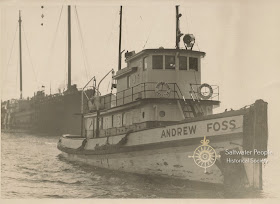22 August 2013
Ron Meng (1954-2013)
 |
Ron and Jennifer Meng, 1970s I.M.C., Lopez Island, WA. Original photo from the archives of the S. P. H. S.© |
The founder and owner of Islands Marine Center, Lopez Island, was a self-made man. Ron started Islands Marine Center c. 40 years ago, literally from the trunk of his car, servicing what was then a sizable fishing fleet on Lopez.
Gradually, he and his wife Jennifer purchased waterfront property, developed a full-service marina and shifted their emphasis to recreational boaters as the commercial fishing industry waned. Ron designed and marketed his own brand of northwest-style boat, the Ocean Sport Roamer. Coming up on hull No. 100, this unique brand was a source of great pride for Ron, as he engaged his favorite pastime, fishing trips to Barkley Sound.
Above text from The Journal of the San Juans
September 2013
GEMINI (ex-WESTERN FLYER)
Up from the bottom of Swinomish Slough and hauled out on the hard at Port Townsend is the vessel known widely as the transport for John Steinbeck, Ed Ricketts, and crew, to the Sea of Cortez in 1940.
A review of Steinbeck's book, The Log from the Sea of Cortez can be viewed here.
A Spring 2015 update of the vessel plans can be viewed here.
13 September 2013
Ferry HYAK collision in Harney Channel, ca. one mile north of Lopez Island ferry landing, San Juan County, WA.
27 October 2013
Seattle sailor Bill Buchan was honored on this day with his induction into the National Sailing Hall of Fame, which took place this year, in the historic waterfront district of Annapolis.
Bill won first place in the 3 Star Class World Championships in 1961, 1970, and 1985.
The Star-type boats are one of the world's oldest organized classes. Each boat was built to rigid specifications to make winning a factor more of skippering rather than hull design. The Star is a keel-type boat about 23-ft long, 5-ft beam, and weighing a little less than 1,500-lbs.
6 December 2013
Anacortes, Fidalgo Island, WA.
Into little Anacortes, on this date, and with "security escorts," came the oldest trophy in international sport, affectionately known as the "Auld Mug".
The sterling silver America's Cup was originally awarded in 1851 for a race around the Isle of Wight in England, won by the yacht AMERICA.
For the celebration at the Watermark Bookstore and the Anacortes Yacht Club, came the Commodore of the Golden Gate Yacht Club, Norbert Bajurin, and Mark Turner, the Anacortes-based builder of the ORACLE boats.
Turner and Cafe Adrift helped with hosting and celebrating the public event.
Gradually, he and his wife Jennifer purchased waterfront property, developed a full-service marina and shifted their emphasis to recreational boaters as the commercial fishing industry waned. Ron designed and marketed his own brand of northwest-style boat, the Ocean Sport Roamer. Coming up on hull No. 100, this unique brand was a source of great pride for Ron, as he engaged his favorite pastime, fishing trips to Barkley Sound.
Above text from The Journal of the San Juans
September 2013
GEMINI (ex-WESTERN FLYER)
.jpg) |
GEMINI (ex-WESTERN FLYER) Famous as the vessel used on Steinbeck's Sea of Cortez expedition. Photo location, Port Townsend, WA., donated by Skip Bold, 9/2013. |
A review of Steinbeck's book, The Log from the Sea of Cortez can be viewed here.
A Spring 2015 update of the vessel plans can be viewed here.
13 September 2013
Ferry HYAK collision in Harney Channel, ca. one mile north of Lopez Island ferry landing, San Juan County, WA.
27 October 2013
Seattle sailor Bill Buchan was honored on this day with his induction into the National Sailing Hall of Fame, which took place this year, in the historic waterfront district of Annapolis.
Bill won first place in the 3 Star Class World Championships in 1961, 1970, and 1985.
The Star-type boats are one of the world's oldest organized classes. Each boat was built to rigid specifications to make winning a factor more of skippering rather than hull design. The Star is a keel-type boat about 23-ft long, 5-ft beam, and weighing a little less than 1,500-lbs.
 |
Bill Buchan, up, and Steve Ericsson, crossing the finish line for an Olympic gold medal, Star class, 10 August 1984. Original photo from the archives of the S. P. H. S.© |
Anacortes, Fidalgo Island, WA.
The sterling silver America's Cup was originally awarded in 1851 for a race around the Isle of Wight in England, won by the yacht AMERICA.
For the celebration at the Watermark Bookstore and the Anacortes Yacht Club, came the Commodore of the Golden Gate Yacht Club, Norbert Bajurin, and Mark Turner, the Anacortes-based builder of the ORACLE boats.
Turner and Cafe Adrift helped with hosting and celebrating the public event.
 |
| THE AMERICA'S CUP Watermark Bookstore, Anacortes, Dec. 2013. |
















.jpg)


